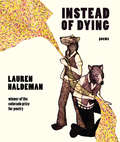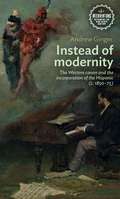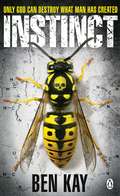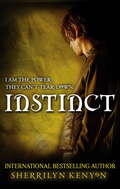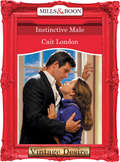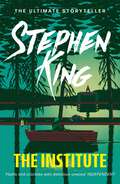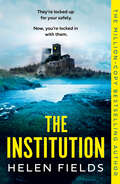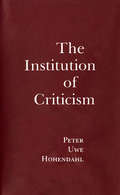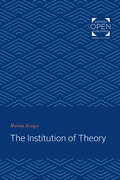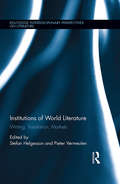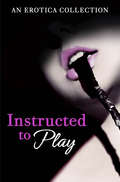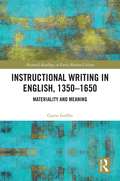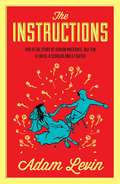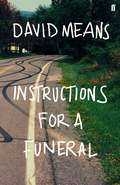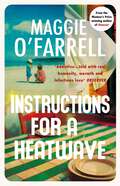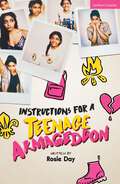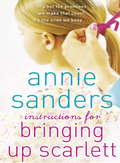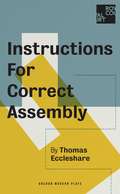- Table View
- List View
Instauration der Erde: Konstitutives Erzählen im Anthropozän und die kritischen Zonen der Literatur (Environmental Humanities #2)
by Simon ProbstMit dem Anthropozän wird oft das Entstehen einer planetaren Universalität und die ‚Wiederkehr der großen Erzählungen‘ verknüpft. Die Verflechtungen von Menschen und Erde werden hier zur Grundlage kultureller Selbstverständigung. Das Buch untersucht strukturelle Merkmale und Problemkonstellationen dieser erdgebundenen konstitutiven Erzählungen. Wie können sie globale Ungleichheiten berücksichtigen? Wie lassen sie die Erde und andere Spezies zu Wort kommen? Inwiefern sind diese Erzählungen selbst planetare Kräfte? Und: Wie kann das Eigenwissen der Literatur unseren Blick auf die Erde erweitern? Diese Fragen werden im Dialog von Wissenschaft und Literatur untersucht. Eingehende Lektüren verbinden kanonische Texten des Anthropozän-Diskurses (z.B. Dipesh Chakrabarty, Donna Haraway, Bruno Latour und Isabelle Stengers) mit literarischen Stimmen (Ursula K. Le Guin, Daniel Falb, Christoph Ransmayr).
Instead of Dying (Colorado Prize for Poetry)
by Lauren HaldemanInvoking spiders and senators, physicists and aliens, Lauren Haldeman’s second book, Instead of Dying, decodes the world of death with a powerful mix of humor, epiphany, and agonizing grief. In the spirit of Calvino’s Invisible Cities, these poems compulsively imagine alternate realities for a lost sibling (“Instead of dying, they inject you with sunlight & you live” or “Instead of dying, you join a dog-sledding team in Quebec”), relentlessly recording the unlived possibilities that blossom from the purgative magical thinking of mourning. Whether she is channeling Google Maps Street View to visit a scene of murder (“Because / a picture of this place is / also a picture of you”) or investigating the origins of consciousness (“Yes, alien / life-forms exist / they are your thoughts”), Haldeman wrenches verse into new sublime forms, attempting to both translate the human experience as well as encrypt it, inviting readers into realms where we hover, plunge, rise again, and ascend.
Instead of modernity: The Western canon and the incorporation of the Hispanic (c. 1850–75) (Interventions: Rethinking the Nineteenth Century)
by Andrew GingerThis book revisits the claim that a key dimension of cultural modernity – understood as a turn to the autonomy of the signs and the erasure of the 'face of man' - arose in the mid-nineteenth century. It presents an alternative to that obsession, focusing instead on the aesthetic appreciation of forms through which connections are realised across place and time. The book is one of few to offer a comparative approach to numerous major writers and artists of this period over diverse countries. Specifically, the comparative approach overcomes the constitutively ambiguous relation between the modern and the Hispanic. The Hispanic is often imagined as at once foundational for and excluded from the modern world. Its reincorporation into the story of the mid-century unsettles the notion of modernity. The book offers instead an experiment in writing, tracing commonalities across place and time, and drawing on mid-century expressions of such likenesses.
Instead of modernity: The Western canon and the incorporation of the Hispanic (c. 1850–75) (Interventions: Rethinking the Nineteenth Century)
by Andrew GingerThis book revisits the claim that a key dimension of cultural modernity – understood as a turn to the autonomy of the signs and the erasure of the 'face of man' - arose in the mid-nineteenth century. It presents an alternative to that obsession, focusing instead on the aesthetic appreciation of forms through which connections are realised across place and time. The book is one of few to offer a comparative approach to numerous major writers and artists of this period over diverse countries. Specifically, the comparative approach overcomes the constitutively ambiguous relation between the modern and the Hispanic. The Hispanic is often imagined as at once foundational for and excluded from the modern world. Its reincorporation into the story of the mid-century unsettles the notion of modernity. The book offers instead an experiment in writing, tracing commonalities across place and time, and drawing on mid-century expressions of such likenesses.
Instinct
by Ben KayHidden in a remote corner of the South American jungle is a clandestine research facility known simply as MEROS. Here, working in laboratories buried a thousand feet underground, military scientists have developed the most astonishing and deadly weapon known to man . . .Meanwhile, on the other side of the globe, a Chinook helicopter lands a highly trained squad of special forces soldiers deep in hostile territory - their mission: to clean up a black-ops killzone. As they enter the cave, they hear the faint buzz of the weapon - like the beating of a thousand pairs of insect wings . . .
Instinct: Chronicles Of Nick (Chronicles of Nick #Bk. 6)
by Sherrilyn KenyonZombies, demons, vampires, shapeshifters - another day in the life of Nick Gautier - and those are just his friends. But now that he's accepted the demon that lives inside him, he must learn to control it and temper the very emotions that threaten the lives of everyone he cares for. Something that's hard to do while trying to stay off the menus of those who want his head on a platter. And no one wants him more than the dark gods who created his race. Now that they know where he is, they will stop at nothing to reclaim him. And without knowing it, Nick has just embraced the one person he should never have trusted. The one person who will hand him over to his enemies to get back the life they lost.Nick has finally accepted his fate, now he must learn to defy his destiny, and the dark, deadly forces that will stop at nothing to destroy everyone he loves so that they can again return to the world of man and own it.
Instinctive Male (Heartbreakers #10)
by Cait LondonPast experience had taught Mikhail Stepanov to keep his boss's dangerously alluring daughter at arm's length. But once the desperate single mother turned to him, how could he resist? In his embrace, Ellie wasn't the willful heiress he remembered but a fiery temptress he was determined to have and to hold forever….
The Institute: A Novel
by Stephen King'It does everything you'd expect of a masterpiece - and it is one' Sunday Express'Hums and crackles with delicious unease' Independent'A captivating, hybrid novel that shape-shifts through several genres' The Sunday TimesDeep in the woods of Maine, there is a dark state facility where kids, abducted from across the United States, are incarcerated. In the Institute they are subjected to a series of tests and procedures meant to combine their exceptional gifts - telepathy, telekinesis - for concentrated effect. Luke Ellis is the latest recruit. He's just a regular 12-year-old, except he's not just smart, he's super-smart. And he has another gift which the Institute wants to use...Far away in a small town in South Carolina, former cop Tim Jamieson has taken a job working for the local sheriff. He's basically just walking the beat. But he's about to take on the biggest case of his career.Back in the Institute's downtrodden playground and corridors where posters advertise 'just another day in paradise', Luke, his friend Kalisha and the other kids are in no doubt that they are prisoners, not guests. And there is no hope of escape.But great events can turn on small hinges and Luke is about to team up with a new, even younger recruit, Avery Dixon, whose ability to read minds is off the scale. While the Institute may want to harness their powers for covert ends, the combined intelligence of Luke and Avery is beyond anything that even those who run the experiments - even the infamous Mrs Sigsby - suspect.Thrilling, suspenseful, heartbreaking, THE INSTITUTE is a stunning novel of childhood betrayed and hope regained.
The Institute
by Maria Del ReyWhen Lucy is sentenced to be rehabiliated in a bizarre institute for the treatment of delinquent girls, she finds that the discplinary methods used are not what she has been led to expect. They are, in fact, decidedly perverse.
The Institution
by Helen Fields‘Brilliant! The Institution is a harrowing, nonstop story that will grab you from the first page and not let go. Helen Fields is a master of suspense. You’ll consume it in one sitting.’ – International bestselling sensation JEFFERY DEAVER They’re locked up for your safety. Now, you’re locked in with them.
The Institution of Criticism
by Peter Uwe HohendahlGerman radicals of the 1960s announced the death of literature. For them, literature both past and present, as well as conventional discussions of literary issues, had lost its meaning. In The Institution of Criticism, Peter Uwe Hohendahl explores the implications of this crisis from a Marxist perspective and attempts to define the tasks and responsibilities of criticism in advanced capitalist societies. Hohendahl takes a close look at the social history of literary criticism in Germany since the eighteenth century. Drawing on the tradition of the Frankfurt School and on Jürgen Habermas’s concept of the public sphere, Hohendahl sheds light on some of the important political and social forces that shape literature and culture. The Institution of Criticism is made up of seven essays originally published in German and a long theoretical introduction written by the author with English-language readers in mind. This book conveys the rich possibilities of the German perspective for those who employ American and French critical techniques and for students of contemporary critical theory.
The Institution of Theory
by Murray KriegerIn The Institution of Theory, Murray Krieger examines, at once sympathetically and critically, the process by which theory has become institutionalized in the American academy and the consequences of theory as an academic institution. He traces the transformation of literary theory into critical theory and relates it to changes in the place of literature within questions about discourse at large. And he faces the costs as well as the gains of the recent denial of privilege to the literary. To support his view of the issues at stake in current theoretical debates, Krieger surveys both the history of American criticism and the general history of literary theory in the West. He sees divisions in each of them that foreshadow the current debates: in the first a conflict between the social and the aesthetic functions of literature, and in the second a conflict between the treatment of literature as a reflection of a culture's ideology and the treatment of literature as a subversion of that ideology. To what extent, he asks, are our debates new and to what extent are they merely refashioned versions of those we have always had?
The Institution of Theory
by Murray KriegerOriginally published in 1994. In The Institution of Theory, Murray Krieger examines, at once sympathetically and critically, the process by which theory has become institutionalized in the American academy and the consequences of theory as an academic institution. He traces the transformation of literary theory into critical theory and relates it to changes in the place of literature within questions about discourse at large. And he faces the costs as well as the gains of the recent denial of privilege to the literary. To support his view of the issues at stake in current theoretical debates, Krieger surveys both the history of American criticism and the general history of literary theory in the West. He sees divisions in each of them that foreshadow the current debates: in the first a conflict between the social and the aesthetic functions of literature, and in the second a conflict between the treatment of literature as a reflection of a culture's ideology and the treatment of literature as a subversion of that ideology. To what extent, he asks, are our debates new and to what extent are they merely refashioned versions of those we have always had?
Institutions of World Literature: Writing, Translation, Markets (Routledge Interdisciplinary Perspectives on Literature)
by Pieter Vermeulen Stefan HelgessonThis volume engages critically with the recent and ongoing consolidation of "world literature" as a paradigm of study. On the basis of an extended, active, and ultimately more literary sense of what it means to institute world literature, it views processes of institutionalization not as limitations, but as challenges to understand how literature may simultaneously function as an enabling and exclusionary world of its own. It starts from the observation that literature is never simply a given, but is always performatively and materially instituted by translators, publishers, academies and academics, critics, and readers, as well as authors themselves. This volume therefore substantiates, refines, as well as interrogates current approaches to world literature, such as those developed by David Damrosch, Pascale Casanova, and Emily Apter. Sections focus on the poetics of writers themselves, market dynamics, postcolonial negotiations of discrete archives of literature, and translation, engaging a range of related disciplines. The chapters contribute to a fresh understanding of how singular literary works become inserted in transnational systems and, conversely, how transnational and institutional dimensions of literature are inflected in literary works. Focusing its methodological and theoretical inquiries on a broad archive of texts spanning the triangle Europe-Latin America-Africa, the volume unsettles North America as the self-evident vantage of recent world literature debates. Because of the volume’s focus on dialogues between world literature and fields such as postcolonial studies, translation studies, book history, and transnational studies, it will be of interest to scholars and students in a range of areas.
Institutions of World Literature: Writing, Translation, Markets (Routledge Interdisciplinary Perspectives on Literature)
by Pieter Vermeulen Stefan HelgessonThis volume engages critically with the recent and ongoing consolidation of "world literature" as a paradigm of study. On the basis of an extended, active, and ultimately more literary sense of what it means to institute world literature, it views processes of institutionalization not as limitations, but as challenges to understand how literature may simultaneously function as an enabling and exclusionary world of its own. It starts from the observation that literature is never simply a given, but is always performatively and materially instituted by translators, publishers, academies and academics, critics, and readers, as well as authors themselves. This volume therefore substantiates, refines, as well as interrogates current approaches to world literature, such as those developed by David Damrosch, Pascale Casanova, and Emily Apter. Sections focus on the poetics of writers themselves, market dynamics, postcolonial negotiations of discrete archives of literature, and translation, engaging a range of related disciplines. The chapters contribute to a fresh understanding of how singular literary works become inserted in transnational systems and, conversely, how transnational and institutional dimensions of literature are inflected in literary works. Focusing its methodological and theoretical inquiries on a broad archive of texts spanning the triangle Europe-Latin America-Africa, the volume unsettles North America as the self-evident vantage of recent world literature debates. Because of the volume’s focus on dialogues between world literature and fields such as postcolonial studies, translation studies, book history, and transnational studies, it will be of interest to scholars and students in a range of areas.
Instructed to Play
byTen sexy stories about bad behaviour and the disciplinary measures taken to correct it. Original erotica from Monica Belle, Rose de Fer, Liz Coldwell, Heather Towne, and many more.
Instructional Writing in English, 1350-1650: Materiality and Meaning (Material Readings in Early Modern Culture)
by Carrie GriffinExploring the nature of utilitarian texts in English transmitted from the later Middle Ages to c. 1650, this volume considers textual and material strategies for the presentation and organisation of written knowledge and information during the period. In particular, it investigates the relationship between genre and material form in Anglophone written knowledge and information, with specific reference to that which is usually classified as practical or 'utilitarian'. Carrie Griffin examines textual and material evidence to argue for the disentangling of hitherto mixed genres and forms, and the creation of 'new' texts, as unexplored effects of the arrival of the printing press in the late fifteenth century. Griffin interrogates the texts at the level of generic markers, frameworks and structures, and studies transmission and dissemination in print, the nature of and attitudes to printed books, and the audiences they reached, in order to determine shifting attitudes to books and texts. Learning and Information from Manuscript to Print makes a significant contribution to the study of so-called non-literary textual genres and their transmission, circulation and reception in manuscript and in early modern printed books.
Instructional Writing in English, 1350-1650: Materiality and Meaning (Material Readings in Early Modern Culture)
by Carrie GriffinExploring the nature of utilitarian texts in English transmitted from the later Middle Ages to c. 1650, this volume considers textual and material strategies for the presentation and organisation of written knowledge and information during the period. In particular, it investigates the relationship between genre and material form in Anglophone written knowledge and information, with specific reference to that which is usually classified as practical or 'utilitarian'. Carrie Griffin examines textual and material evidence to argue for the disentangling of hitherto mixed genres and forms, and the creation of 'new' texts, as unexplored effects of the arrival of the printing press in the late fifteenth century. Griffin interrogates the texts at the level of generic markers, frameworks and structures, and studies transmission and dissemination in print, the nature of and attitudes to printed books, and the audiences they reached, in order to determine shifting attitudes to books and texts. Learning and Information from Manuscript to Print makes a significant contribution to the study of so-called non-literary textual genres and their transmission, circulation and reception in manuscript and in early modern printed books.
The Instructions: Book One
by Adam Levin‘Adam Levin’s book is the real thing, I think. It appeals to the young readers who like formal invention and ambition... But there’s also real substance there.’ Dave Eggers This is the story of Gurion Maccabee, age ten: a lover, a fighter, a scholar, and a truly spectacular talker. Gurion has been expelled from three Jewish day-schools for acts of violence and messianic tendencies. He ends up in the Cage, a special lockdown program for the most hopeless cases at Aptakisic Junior High. But in just four days, from the moment he meets the beautiful Eliza June Watermark to the terrifying Events of November 17, Gurion’s search for righteousness sparks a violent, unstoppable rebellion. Driven equally by moral fervour and teenage exuberance, The Instructions is hilarious, troubling, empathetic, monumental, breakneck, romantic and unforgettable. ‘Evocative of David Foster Wallace... full of death-defying sentences, manic wit, exciting provocations and simple human warmth.’ Rolling Stone ‘This is a life-consuming novel, one that demands to be read feverishly. When it is over, other fiction feels insufficient, the newspaper seems irrelevant...’ New York Observer ‘A hysterical, heartfelt journey of self-discovery... A book that moves beyond completely transparent influences to reach its own distinct, new, great height.’ Village Voice ‘Manic, articulate, full of passions, courageous in its form and very funny.’ George Saunders
Instructions for a Funeral: Stories
by David MeansAfter winning international acclaim with his first novel, the Man Booker-nominated Hystopia, David Means returns to the form that made his name in Instructions for a Funeral, a collection of fourteen masterful stories that run the gamut from the playful to the personal. 'The Terminal Artist,' originally published in Vice, skirts reportage in grappling with the revelation that the death of a hospitalized loved one was in fact a murder; 'The Tree Line, Kansas, 1934,' from the New Yorker, is a wry anatomy of the moments before an FBI raid goes spectacularly wrong; while 'The Chair,' from The Paris Review, gives us a clear-eyed look at fatherhood, with all its paradoxes, recriminations, and rewards gloriously intact. Means's work has earned him comparisons to Flannery O'Connor, Hemingway, Sherwood Anderson, Denis Johnson, Poe, Chekhov, and Carver - but his place in the American literary landscape is fully and originally his own.
Instructions for a Heatwave
by Maggie O'FarrellA story of a dysfunctional but deeply loveable family reunited, set during the legendary summer of 1976, INSTRUCTIONS FOR A HEATWAVE by Maggie O'Farrell was shortlisted for the 2013 Costa Novel Award and was a Sunday Times Top Ten bestseller.It's July 1976. In London, it hasn't rained for months, gardens are filled with aphids, water comes from a standpipe, and Robert Riordan tells his wife Gretta that he's going round the corner to buy a newspaper. He doesn't come back. The search for Robert brings Gretta's children - two estranged sisters and a brother on the brink of divorce - back home, each with different ideas as to where their father might have gone. None of them suspects that their mother might have an explanation that even now she cannot share.
Instructions for a Teenage Armageddon (Modern Plays)
by Rosie DayAnd I think you can tell a lot about a person by what they choose to see in you.She was a 17 year old girl; the only God she believed in was Taylor Swift.After her sister's untimely death by a Yorkshire Pudding, a funny teenage misfit begrudgingly joins a flailing scout group to help her navigate the kicks and punches of adolescence with varying degrees of success.Rosie Day's debut play Instructions for a Teenage Armageddon is a rollercoaster ride through youth. Whether you are a young person, know a young person, or simply were a young person once – it's time to rip up the rule book and reconnect with your younger self.This edition was published to coincide with the production which opened at the West End's Garrick Theatre in March 2024.
Instructions for a Teenage Armageddon (Modern Plays)
by Rosie DayAnd I think you can tell a lot about a person by what they choose to see in you.She was a 17 year old girl; the only God she believed in was Taylor Swift.After her sister's untimely death by a Yorkshire Pudding, a funny teenage misfit begrudgingly joins a flailing scout group to help her navigate the kicks and punches of adolescence with varying degrees of success.Rosie Day's debut play Instructions for a Teenage Armageddon is a rollercoaster ride through youth. Whether you are a young person, know a young person, or simply were a young person once – it's time to rip up the rule book and reconnect with your younger self.This edition was published to coincide with the production which opened at the West End's Garrick Theatre in March 2024.
Instructions for Bringing Up Scarlett
by Annie SandersIt's not the promises we make that count, it's the ones we keep...Alice is living the life she always dreamed of: a travel guide writer, her life is one of carefree adventure, with no ties, no constraints and no worries. Virginia finally has everything she ever wanted. The loving husband, the beautiful daughter and the successful career. Life hasn't always been easy, but she knows that her family can weather any storm.They have been best friends since university - so much so that Virginia trusts Alice with all she holds dearest. Then tragedy strikes, and Alice finds she must honour a rash promise she made to her friend. It's then she discovers that it can be the people you think you know best who hold the most closely guarded secrets...
Instructions for Correct Assembly (Oberon Modern Plays)
by Thomas Eccleshare“Maybe turn down the ‘opinionated’ dial?” Hari and Max weren’t satisfied with their first attempt at parenthood, so they’re giving it a second go. Only this time they’ve got a 30-day money back guarantee and an easy-to-follow construction manual. They’re certain, as long as they follow it step-by-step, he’s going to be perfect. “This might be a little more complicated than the bed but still, I’m sure it’s the kind of thing we can crack on our own.” Instructions for Correct Assembly premiered at the Royal Court Theatre, London, in the Jerwood Theatre Downstairs on 7 April 2018, in a production directed by Hamish Pirie.

